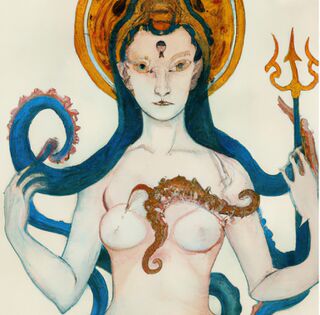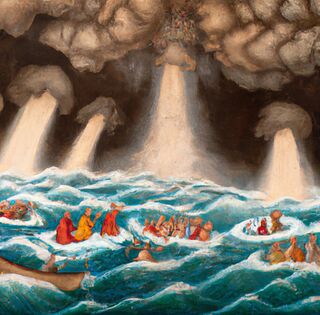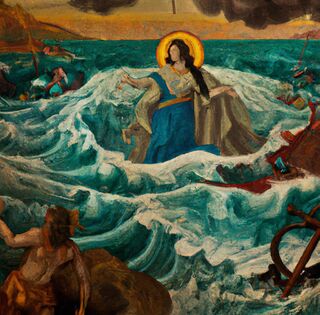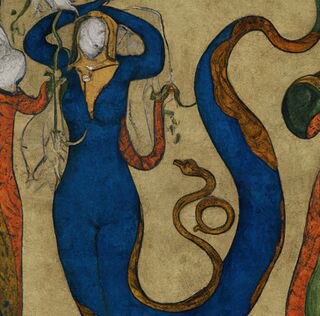Church of the Tidemother
History
The Songs of Storms are a collection of various pagan religious beliefs and ancient cultural traditions that were reformed into a single organized religion by the Church of the Tidemother and the first Tidespeaker, Lord Umerith Stromhar, in the Year 49 on Dwilight with the assent of the Tol Goldoran Navarch, Solomon Greybrook.
Officially founded in the crumbling ruins of Via Fortress, Umerith Stromhar founded the first Holy Site for the Church, an in-land Archive called Stormsong Academy, both because of its central location in Western Dwilight and the defensive location of Via Fortress. This Academy would act as an information vault for the Citizenry and an educational center for the Priests.
Beliefs and Practices
General
The Church primarily worships the Goddess of Water and Air, simply known as the Tidemother, but more specifically worships that of the Oceans, Rivers, and Storms of Dwilight, which fall under her vast domain.
It is said in the Songs of Storms that of all the Void Gods that have existed since time immemorial, The Tidemother is the most powerful and the least understood - as such, The Storm Sages sought to know her better, and dedicate their lives to documenting her lessons and gifts, whilst soothing her grief and rage with songs of praise and love.
The Storm Sages used to be a disorganized and varied group of pagan, Ocean-worshipping Druids but were reformed into an organized Church by Tidespeaker Umerith Stromhar in Year 49. A lot of the Oral traditions and Songs were transcribed into the written format by Scribes for future reference, forming a more comprehensive and easy to follow set of scriptures rather than a varied selection that differed from Region to Region.
The faith in general worships all things water and air, seeing them as not two separate elements but two separate parts of the Tidemother - Rivers bring life and irrigation whilst allowing trade and fishing, Ships are blessed by a Waveweaver prior to setting sail and always have at least one Galecaller on board to ensure the Sails are full of Air - Stormsingers bless Farmlands with rain and sing to Storms to placate the raging winds, and all honorable burials take place at Sea. Fire and Earth are in turn seen not as evil as such, but tools stolen or used by the Void Gods to trick or force man into worshipping them.
In fact, the Raging Seas and Chaotic Storms act as a basis of which followers and priests of the Church live by in day to day life - Water can be calm and soothing like a Lake, and so too can Man, but both can also carve it’s mark into the Earth, like raging rivers. The Sea cannot be tamed and answers to no man or woman, only the Tidemother and her chosen and does what it pleases with no shame or regret. Chaos is both dangerous and beautiful, the natural way of the world, and there is no force of chaos more powerful or as present as The Sea.
In addition to the Songs used to calm her rage, the followers of the Church adhere to the practice of The Price, or Golden Price - ships are sent out to Sea with Gold and Gifts for the Tidemother, and the wealthy/affluent are given a Sea Burial with wealth and belongings in order to present to her in The Mists. This is because it was Gold and Wealth being sat upon by the greedy and the cowards that corrupted man, and so they willingly decide to give up their worldly possessions upon death in apology.
The Sunken Land and the Void
As Man began to form in the world, it was the Tidemother, not the False Gods, who gave them what they needed to live and asked for nothing in return except their worship. She raised a Great Islands from her Seas for them to call home. As they thirsted, she gifted them water to drink. When their crops failed, she called rain in which to help them grow stronger. Rivers flowed, carving through the land to carry an abundance of fish, and boats passed harmlessly through her waves.
But displeasing her would invoke her wrath - coastal villages were wiped out by destructive waves, and storms ripped through towns and cities that did not bestow enough gifts or favor upon her. Her maternal side earned her the name of Tidemother, and her rage earned her both reverence and fear in the hearts of men. Kingdoms rose and fell at her whim, and the surface of the world changed with the winds of wars and storms.
But voices began to whisper in the ears of Men, planting the seed of greed and calling it stability instead - promising order and power if only Man worshipped the Void Gods and not the Tidemother.
As the Void Gods corruption began to cross the waves and taint the World with unsustainable Order, the Tidemother's love turned to rage - she sunk the most corrupt Land, casting the Void Gods and their worshippers to the deepest depths, known only as The Void, where they took hideous shapes and forms, afflicted by their greed and the crushing dark, so all would know their corruption upon sight.
The New Lands and Void Gods
One particular band of mortals cast adrift in the raging waters, following the sinking of the corrupted land, reflecting on their betrayal of the Tidemother, began to raise their voices in a harmonious prayer of apology and worship. This became known as the First Song, and those that sung loudest became known as the Stormsingers, for their voices, carried over the crashing waves and raging storms to the Tidemother herself.
Although still furious, the Tidemother heard this Song, and with one last act of pity on Man, calmed the waters and allowed the Survivors to sail to The New Lands and new homes. Their ships were protected from the jagged bones of the sunken land and passed through the Boiling Seas to Dwilight.
When they arrived on the shores of Western Dwilight, Man celebrated the Tidemother once more, but now found her gifts absent and her voice quiet. Many turned away from her, once again seeking the comfort of the Void Gods who had escaped The Sunken Land, but the Stormsingers vowed to continue singing their apology to the Tidemother until one day the World was united in The First Song.
Only once the Void Gods were cast down to The Void to join their Brethren, and the World was united in the First Song, would Man be forgiven for their betrayal.
Holy Sites
Stormsong Academy, Via - Stormsong Academy was officially the First Holy Site created in the name of the Church of the Tidemother. Tidespeaker Umerith Stromhar, in his capacity as Lord of Via, converted his Estate into a Grand Academy opposite the First Church, dedicated to the documentation of religious history, educating the local populace and the training of Priests for the Church.
Holy Artifacts
None yet.
Structure
Tidefather
The Tidefather was an honorary rank bestowed upon the First of the Church and Founder of the Religion - Lord Umerith Stromhar of Tol Goldora. Forever honored as the Oracle of the Faith, it is said that when he passes from the world, whether it be in battle or in his bed, the loss of his voice in the Songs of Storms will be felt by the Tidemother herself, who will guide his funeral boat to her side. Whilst the Tidefather exists, he fulfills the role of the Tidespeaker.
Tidespeaker
The Tidespeaker is the Head of the Church of the Tidemother (when the Tidefather has passed), and acts as both a traditional Lord over a fiefdom would as well as the Religious Head of the Church. Highest above all and closest to the Tidemother behind the Tidefather, the Tidespeaker is a deeply respected position and carries with it the responsibility of ensuring the Church's continued existence and spread, as well as the appointment of the Storm Sages.
The Storm Sages and the Stormsage Council
The ruling body of the Church under the Tidespeaker, to be a Storm Sage is to be awarded the highest honor for Priests in the Church. A Storm Sage is considered experienced and knowledgeable in the scriptures, and world-wise as an individual. The Sages form the Council, which is in charge of proposing new scriptures to be adopted and advising both the Tidespeaker and followers on matters of faith.
Stormsinger
Stormsingers are the most common Priests in the Church, and many often remain in the Church Grounds or Holy Sites constantly singing to the First Song in reverence of the Tidemother.
However, the more active Stormsingers travel the land, bringing the Songs of Storms to the Commoners and Nobility, blessing ceremonies or Farms, or calming storms with prayers. The Stormsingers are in general more likely to be scholars than priests but are as important to the running of the Church all the same due to their knowledge of the scriptures.
Waveweaver
Waveweavers are Members or Priests of the Church who have specifically dedicated their time and faith to the reverence of the Rivers and Shores of Dwilight. Waveweavers are often as popular as Stormsingers in matters of marriage or ceremony, as many Tide Ceremonies such as funerals are held on beaches or riverbanks, but are also officially tasked with the blessing and assisted management of ships and fleets.
Before a raid or after the completion of construction, the Waveweaver shall perform a blessing which will be carved into the ship with a ceremonial knife, and when a Noble or Ship has expired and is to be cast into the Sea to return to the Tidemother, the Waveweaver will grant them the final rites the same way - a Noble will be interred in a ship, either their own or one awaiting passage, and the final rites carved into the ship’s hull.
Galecaller
Galecallers are essentially battle priests or consecrated members, and can often be found attached to raiding parties or are part of an active ship's crew. The Galecaller's role is, therefore, to ensure a ship's sail is always full of air via prayer, and to act as navigator and scout for the raiding party on land - they also fulfill a minor religious role where a worshipper of the Tidemother does not have a Waveweaver or Stormsinger on hand, such as battlefield blessings or burials, and many Galecallers often retire as Stormsingers or Wavecallers, if not Storm Sages, in later life.
In any instance, it is considered extremely bad luck or bad form to not have a Galecaller present on a raid or when traveling the Seas.
Thunderborn
The Thunderborn are some of the fiercest warriors and defenders of the Faith the Church could hope for. They are not Priests and are not expected to necessarily know the Scriptures inside-out, but those designed Thunderborn are described as being steadfastly loyal to the Church and Tidemother - and a fierce Warriors, too.
Thunderborn are treated with great respect among followers of the Church. This role is given to any warrior who proves themselves in the Tidespeaker's eyes and devotes themselves to the Tidemother first and foremost before all.
| The Tidespeakers and Stormsages | |
|---|---|
| Name | Description |
| Tidefather Umerith | It was the First Tidespeaker who became the Tidefather of the Church, and chosen Avatar of the Tidemother herself on land. Umerith was directly responsible for the organization of the different pagan factions who worshipped her and forming them into a centralized, organized Religion from the Fortress of Via. |
| Masters of the Tide | |
|---|---|
| Name | Description |
| None yet. | |
| Heroes of the Sea | |
|---|---|
| Name | Description |
| None yet. | |
| The Honoured Dead | |
|---|---|
| Name | Description |
| None yet. | |
| The Disgraced | |
|---|---|
| Name | Description |
| None yet. | |
Gods and Demons
The Tidemother
The Tidemother is a primary deity worshipped by the Church. She is mostly depicted as both a beautiful and haunting humanoid being, the upper body being that of a woman, and the lower body that of a scaley cephalopod, though how she is viewed can vary from region to region. Regardless, the common theme of the Church is that of Mollusc based appendages and iconography in honor of the Tidemother.
She is not depicted as an all-good or wholly evil being, but instead a primordial entity of water and air capable of incredible calm and beauty as well as terrifying danger. She is not controlled, and her favor is as unpredictable as The Sea. Regardless, whilst it would be easy to simply leave her to her whims and worship other, less volatile Gods, the Sea, Rivers and Lakes, and all the bounty that they bring, are essential to Human survival - and her gifts are not to be scorned or taken without thanks, for she has sunk Islands for much less.
The Elementals
To the Church, the terms Elementals, or Demi-Gods all effectively mean the same thing and are often, though not always, related to the Tidemother in some-way. Although not expressly worshipped like the Tidemother, many Elementals are considered her children and are given respect. Unlike other Religions, Elementals are not considered all-powerful in their respective domains, but an aspect of it. They include;
Aeolus - Much like the Verdis Elementum faith, Aeolus is considered an elemental of Air, but unlike the Verdis Elementumists, Aeolus is the only Elemental of Air, and is the temperamental son of the Tidemother.
The Void Gods
The Void Gods are the Demons of the Church of the Tidemother. Long ago, when the Tidemother sunk Atamara, the False Deities that ruled there were cast down into a realm beneath the Tidemother’s Ocean known as the Void - there, they were trapped in darkness and agony, their forms twisted and writhing in the corruption they brought upon the world. Their followers did not fare much better - those that weren’t trapped with their false masters were twisted into the Monsters and Demons that plague the world today, shadows of their masters with all humanity stripped from them.
The list of Void Gods is long as the years are many, for a long list of False Gods have been routinely cast down into the Void by the Tidemother. It is believed that their followers, Monsters, and Undead, are compelled only to destroy man and the Tidemother so that one day, the Void Gods will rise again.
The Old Ones
WIP.
Documents and Roleplay
Official Documentation
These documents are copied and stored in every Academy/Church of the Tidemother, and thus are readily available to those who wish to read them - providing they are a Full Member;
Significant Roleplay
These encounters are official Roleplays that have taken as part of the Church of the Tidemother. Whilst not known by members of the Church word-for-word, these occasions were documented in the Songs of Storms for future generations, and thus can be learned about by Full Members;




